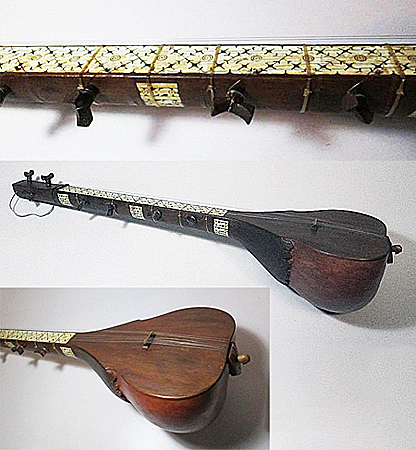
Owner: HWMC
Catalog#: 2AS-CHLT-06-16
Lutes
Afghanistan ‘Tanbur’ (Small)
Northeast, in Mazar-i-Sharif and Kabul, Afghanistan
Afghans
Wood, bone, steel strings, metal, nylon strings (frets)
Mid 20th century
Length: 29 in, Width: 7.75 in, Depth: 5 in
Chordophones – Lutes
This is a small tanbur played in Northern Afghanistan from Kabul to Herat and Maza-E-Shariff and amongst the Uzbeks and Tajiks in small instrumental ensembles, as a solo, or to accompany singing. It has changed over the years and use to look similar to an Indian sitar with a wide neck and gourd-like body. The body of this Afgan tanbur is carved from one piece of mulberry wood and supports a wooden soundboard with a circle of small acoustic pinholes. Both the body and the neck are hallowed out. The neck has a fingerboard that consists of a thin piece of glued on wood that is ornately decorated with bone inlay. There are nylon frets that are knotted to the neck and five t-shaped pegs inserted into the left side to tune the sympathetic metal strings that feed around a pin/post on the left side of the fingerboard. The two main metal strings are attached to the top front T-shaped pegheads. On the soundboard is a wooden bridge to support the melody strings and holes for the sympathetic strings to through as they all attach to a post at the bottom. A wire plectrum fixed to the index finger or a wooden pick is used to play the instrument.
Reference: ATLAS of Plucked Instruments – Central Asia
